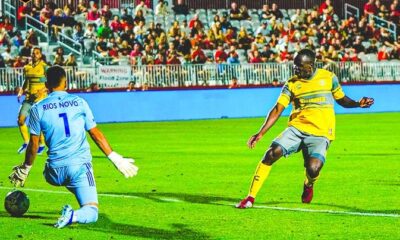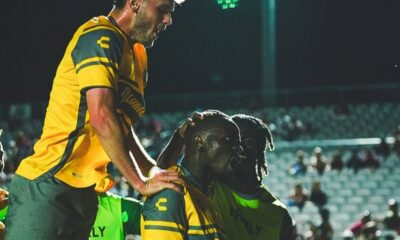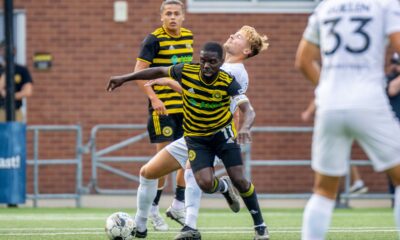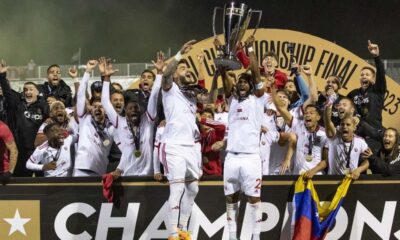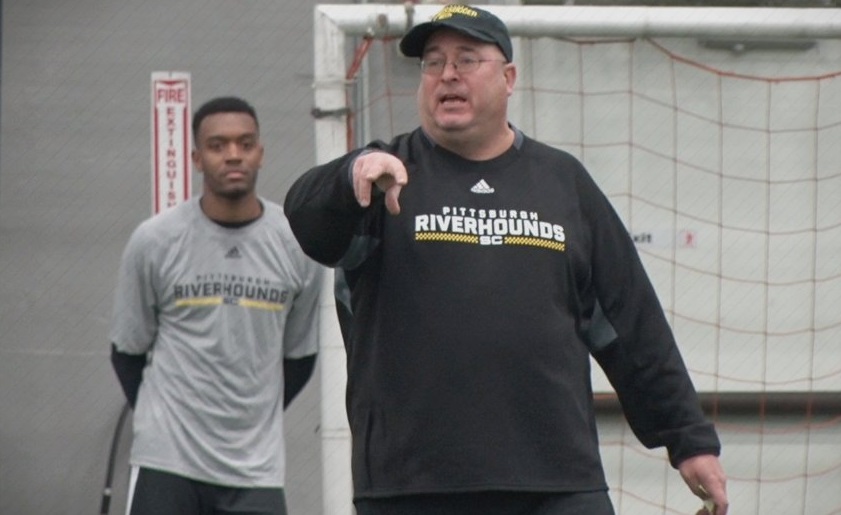
Pittsburgh Riverhounds SC’s coach Bob Lilley has an incredible track record of building successful teams. This is how he does it.
— — —
There must be as many paths to building a trophy-winning soccer club as there are soccer clubs in the world.
It helps to have a giant heap of money like FC Barcelona, but there are always examples out there of expensive flops, like Real Madrid’s ‘Galacticos’. Some clubs like Ajax and Boca Juniors have a reputation for developing fantastic youth players that eventually grow up to help their clubs win cups. Other teams like Club America just have a knack for assembling the right pieces.
In USL, it’s even trickier to put together a championship squad. There’s not a lot of money to throw at players. There’s not an army of coaches and scouts to sift through tape and identify talent. But a smart coach makes do with what he has.
Which is why I wanted to talk at length with Bob Lilley, Pittsburgh Riverhounds SC head coach, about the process of building a successful USL team each season.
Lilley is as smart coach as they come. And he has a reputation for ‘making do’, all the way to the cup. He’s won two USL championship trophies; in 2006 with the Vancouver Whitecaps, and in 2015 with the Rochester Rhinos. In a 20-year coaching career with six teams across three leagues, he’s never once had a losing record. And often, he’s had to do it on a shoestring budget.
Spoiler alert: there’s a degree to which I wasn’t able to divine the ‘secret sauce’ that Bob Lilley uses to find the right players for his team. Coach Lilley has ‘his guys’, and somehow he’s just better at finding the right players and getting the most out of them than any almost every other coach in USL. But it was still quite a treat to sit down for an hour with Bob Lilley and get a look inside the timeline and the thinking goes into crafting a top-caliber USL team.
…
The Next Season Starts As Soon As The Last One Ends
On a frigid January morning in a conference room overlooking the worn turf of the Hounds Highmark Stadium, Coach Lilley grins as he expresses a sense that there is seemingly no end and no beginning for him.
Lilley tells me when the 2019 season started for him. “The minute the (2018) season was over.”
“For the first three weeks, there’s getting our players out of here successfully, paying bonuses left on the contract, making sure the housing is sorted out with them, player meetings, coaches meetings, meeting with the owner.”
The Hounds season, you may recall, ended earlier than many had hoped and with a bit of an anti-climax. After a dominant regular season that gave the Hounds a prime playoff spot, Pittsburgh were ahead 1-0 for 70 minutes in their playoff game against Bethlehem Steel. But after conceding a regular time goal and drawing 2-2 after extra time, the team were dispatched 8 to 7 on penalties against a team they had beaten twice in the regular season and once in preseason.
Certainly, Lilley already had an idea of who he’d retain for 2019, plus or minus a few guys.
“We feel really good about the eleven we kept.* There’s a good balance to that group. It allows us to go get a few new defensive pieces, a few new midfield pieces. We did feel like we needed to change some personnel in the attacking areas. We feel like we were solid in the second half of the season offensively. We were stingy defensively in the first half of the year. And (in the second half of the year) we got better offensively.”
The 2018 Hounds were a defensive juggernaut for much of the season, holding their opponents goalless in 12 of their first 17 contests and conceding only 8 goals all year at home. But their 47 Goals Scored put them in the middle of the pack in terms of offensive production across all of USL.
Lilley felt the team needed to evolve a bit going into 2019 in order to score more goals. “We feel like we still need to take more steps forward to be more consistent, to be a little bit more sophisticated against the better teams. To win it, that needs to be a big priority.”
To that end, the Riverhounds let go of strikers Dennis Chin, Kay Banjo and Romeo Parkes, andmidfielders Ben Fitzpatrick and Ben Zemanski as the 2018 season concluded. Coach Lilley would additionally choose to sell wide midfielder Christiano François to Ottawa for an undisclosed transfer fee, leaving the team with a need to identify some additional scoring options and creative pieces going into the offseason.
Coach Lilley explained the departure of François as a piece of a larger tactical vision. “Christiano is very predictable how he plays; he’s dynamic, he’s explosive. But he’s still getting behind defenses. He’s very good 1v1. He’s a perimeter player. But we want attackers who are good at making runs in behind and getting into goal scoring positions.” In essence, what Lilley wants is players that can attack and shoot but also create. They need attacking pieces that are as much of a threat when they *don’t* have the ball as they are when they are dribbling at you.
Foundations
Lilley made an obvious decision about his first-team defensive unit when he exercised the options of Tobi Adewole, Jordan Dover, and Joe Greenspan to bring them back for the 2019 season. The Hounds head coach then went out and signed free agent fullback Ryan James to form what looks like an early favorite to be the opening day “back four.”
About a month later, the Hounds added another player to the roster when they signed 29-year-old forward Steevan Dos Santos. The Cape Verde-native notched 5 goals last year for an Ottawa Fury squad that only tallied 31 total goals – second-to-worst in the entire 33-team United Soccer League.
What made Lilley want to add James, a sometime-starter for Nashville SC last season, and Dos Santos, an unspectacular striker with Ottawa in 2018? Bob chuckles to himself. “You may not know this, but they both played for me. I trust ’em. Our team will have versatility, we’ll be able to change tactics, we’ll be able to think on our feet. They have good work ethics. Mentality’s good. They’re good in the locker room. They’re good pros. They’re safe.”
And that gets to one of the building blocks of a Bob Lilley roster: ‘Bob’s guys.’ When Lilley came to Pittsburgh, he released a lot of the players from the 2017 Riverhounds roster, while bringing in a significant number of players he’d had in Rochester. These Rochester refugees** came to be known as ‘Rhinohounds’. Now Pittsburgh can say it has two more pieces from Lilley’s days in upstate New York. With Dos Santos and James, he knows what he’s getting. Lilley clearly believes he can get more out of both players than their previous coaches got from them. When Bob says “they’re safe”, he means that he’s started the roster building process by locking down the things that are reliable and certain. He’s got his veterans – his experienced USL guys – that can set the culture and that he knows can play in his system.
Now that the Riverhounds have a base of reliable players, the Hounds coaching staff of Lilley, Assistant Coach Dan Visser and Goalkeeper Coach Hunter Gilstrap can go about finding the right players to add that are more unknown.
The MLS Combine and Superdraft
A week into January, Major League Soccer holds an invite-only combine for top NCAA prospects. This year, fifty players went down to Florida to strut their stuff before MLS and USL coaching staffs. The atmosphere is collegial, but it also sounds a little like the coaching staffs divide themselves like boys and girls at a middle school dance. “As the combine goes on the MLS guys are on one side of the stadium and the USL guys are on the other side” Lilley says.
It’s a challenge for the USL coaches to figure out how to position themselves. He’s got no shot at some of the players, and it isn’t that hard to tell who that may be. “Obviously the top ten that are doing really well, it’s pretty obvious I’m not going to get them.” But there are others that are iffy to get drafted, or even if they get drafted, are iffy to get an actual contract with an MLS team.
If Lilley sees a player that he likes, he might just make a note in his book and consider reaching out down the road if the player is still available. Or he might reach out to the player’s agent immediately to gauge interest. Until the draft is over, or until MLS teams extend invitations to trials though, it’s all just ‘watch and wait.’
The draft and the combine are a good opportunity for USL coaches – perhaps more so than they were in the past. Lilley explains, “Look, five years ago, there could be thirty guys at a combine that could’ve made contributions in MLS. Now that number is maybe ten. Thirty or forty may stay on MLS rosters, but they’ll be allocated to the second team in USL.” MLS is getting better; so USL is getting better. A rising tide lifts all boats. Players at the MLS combine will have a harder time getting drafted than they would have in previous years. And that means more of them will end up in USL.
How many? Hard to tell.
It may be instructive to look at the Colorado Rapids 2018 Superdraft as a good example. The team took five players: Alan Winn, Frantzdy Pierrot, Thomas Olsen, Brian Iloski, and Niki Jackson. All five were invited to Rapids pre-season, but without contracts – they had to play their way onto the roster. Pierrot, Iloski, and Winn all declined the invitation in order to take a chance getting a full contract somewhere else. Pierrot ended up in Belgium with Royal Mouscron. Iloski went to Legia Warsaw and spent the season on loan with a club in Slovakia. Winn signed with the USL’s Nashville SC. Meanwhile Olsen and Jackson accepted the invitation and joined the Colorado Rapids for their January and February pre-season. After a few weeks, Olsen was cut and joined USL’s Las Vegas Lights. Only Jackson earned a contract, staying with the Rapids for the entire 2018 season, where he scored 3 goals in 429 minutes, including one on his debut in the season opener.
Some players are willing to trial in MLS, only to fail and end up in USL. Others would prefer the certainty of a guaranteed contract. And some want the biggest contract they can get, and will wait until their agent can find them a big payday.
The Wild Time
From mid-January to early March is the crazy time for USL teams like the Riverhounds. That’s because every ‘out-of-contract’ player on planet earth – the guys trialing with MLS teams, the players who have been released from USL rosters, plus the thousands of high-level soccer players around the world that are looking to join a squad – are contacting USL teams through their agent.
Lilley explains “You’re getting inundated with agents.” Earlier in the pre-season window, the agents with the best players will come asking for big contracts.
“Everybody that has value is trying to get top dollar early in the process. Everyone has an open canvas, ‘we’ve got to get better’. You’re dealing with agents that have blue-chip prospects. If they don’t feel their player is going to MLS, then they’re thinking ‘can I get him a big contract in USL?’”
For more well-known players and their agents, video isn’t that important. Last year when the Riverhounds signed former midfielder Ben Zemanski from the Portland Timbers, an MLS team, he was already known to be a highly talented footballer. The Hounds were tipped off to Zemanski’s interest because his agent reached out directly to Bob Lilley. “He knew Portland wasn’t bringing him back. We knew (Zemanski) was from the area, and that he would bring some maturity into the group. And I thought he did well for us.”
For lesser-known players, a good video is that foot in the door that’ll get their guy a tryout. Agents from all over the world send video to the Hounds to take a look at. And Lilley and his staff certainly watch a fair amount of it. But some of those players are going to be snapped up by other teams. And there’s also more video coming into the Hounds than any small team could ever actually watch in a short window of time. That’s why the Hounds also want to be smart about the process: to try and find guys that are off the radar of the rest of the soccer world. Lilley told his coaching staff ‘Let’s lets make sure we pay attention to players in NCAA Division II, Division III, and NAIA.’ That’s how the team found Anthony Velarde, a talented creative midfielder from Division II Fresno Pacific University. This past year, he broke the PacWest Conference’s all-time career assist record, finishing with 44 career assists. The club announced his signing on January 14.
Lilley isn’t just signing players based their D2 stats or a highlight reel on Youtube complete with banging golazos and a thumpa-thumpa techno soundtrack, though. He wants to see how they play, and how they practice, under his instructions.
Combine to Conquer
So in addition to the MLS combine, the Hounds host their own combines. Pittsburgh hosted an invitational combine at Highmark Stadium on December 17th and 18th, with between forty and fifty players in attendance. They host another, smaller combine this week, on January 29th and 30th. Both are closed to media.
Players might be invited to multiple combines with multiple USL teams across the country. There is also the ‘Midwest Pro Soccer Combine’, which this year came in late December, and lets dozens of professional coaches view hundreds of players for a few days at an indoor field just west of Detroit.
Lilley signed Velarde after that first combine in Pittsburgh. “We generally don’t sign a lot players directly (out of the first combine), so we hang onto them and keep looking, and at the end if we feel like they’re the best we’ve seen, we’ll sign them.”
The coach knows that these combines are an imperfect instrument. So if he can wait until his already-signed players report to training in February to trial a few possible players, he’ll have better results. “If I have them train side by side with our guys, after a week or two in preseason, I’m going to make a much more informed decision. Now the risk of that is, you may lose a player. But generally he wants to wait to fill out the roster until a bit later in the process.”
It’s not just that delaying your signings can reap better players who are a better fit. Lilley knows he can also get better players cheaper if he waits. That goes for the unsigned veterans as well as the college players that haven’t caught on yet with an MLS or USL team.
“The agents been trying for the two months to get a $4,000 or 5,000-a-month contract. Teams are prioritizing other players. (The players are) out of a job, they’re getting antsy, they don’t want to go out on trial. Those players in January may accept 3,000 a month that wouldn’t have accepted less than $4,500 (a month) two weeks at the end of the (2018) season. Some still won’t get the offer they want and will have to go in on trial.”
Players are balancing certainty against money. A guaranteed deal without the need for going on trial might bring a player less, but at least they won’t have to deal with the anxiety of flying out to three or four teams in hopes of getting a job. Other players and their agents are fine with traveling and trialing, though. They hope that trialing and going to multiple combines might spark the interest of multiple teams, giving their client the opportunity to select the highest bidder.
The Final Pieces
Right now, the Riverhounds have 13 players signed for the 2019 season: forwards Neco Brett and Steevan Dos Santos; midfielders Mouhamed Dabo, Kenardo Forbes, Noah Franke, Kevin Kerr, Thomas Vancaeyezeele, and Anthony Velarde; defenders Tobi Adewole, Jordan Dover, Joe Greenspan and Ryan James; and goalkeepers Kyle Morton. The final pieces will be assembled in just six short weeks. The Riverhounds open the 2019 USL season on March 16 on the road in Tampa Bay against the Rowdies.
Lilley explains, “We will go into camp February 1st with 15 to 16 players signed. Which will leave 7 to 8 spots probably. We’ll bring in 10 to 12 trialists. Some foreign, some from USL, some from college.”
It is clear the team still needs some specific positions filled out. “Depth-wise we’re looking for another left and right back, and two centerbacks. We’re likely to sign at least three defensive players.”
Clearly the team will add at least one more goalkeeper, and probably another striker, unless they plan to use one of their current midfielders in a role higher up on the pitch. Nonetheless, the order in which players were signed is not an indication of where they are valued on depth chart, nor is it necessarily an indication of a player’s future potential for Coach Lilley.
“I don’t look at a roster as ‘well I got my 16 or 18 solid pieces and these six are projects.’ I look at a roster, I want to feel that every player I sign will be able to contribute in some way.”
Will it spell hardware?
Clearly there is unfinished business after a very strong 2018 Hounds team fell short of winning the cup. There’s a strong sense that going out on penalty kicks in just the first round was below the club’s expectation. 2018, then, was a dress rehearsal for 2019.
There is still a lot of building to do, though. There are still nearly a dozen players yet to join the team, and the team has yet to kick a ball in a pre-season game.
There is one last little advantage that Bob Lilley holds over his competitors: his guys want to play for him specifically because he has a history of winning. Forbes told me in October, “Normally, with Bob these couple of years, we’re always in the playoffs.”
For his part, Lilley knows that his track record is a reason soccer players want to be in Pittsburgh, and are even willing to leave the possibility of a bigger contract on the table in favor of playing for him.
“I have players who wanted more money than we eventually agreed upon, but they also wanted to win. They could chase the dollar or they could go play for a trophy.”
— — — — — — — —
* To start the roster for 2019, the Riverhounds chose to retain Tobi Adewole, Neco Brett, Mouhamed Dabo, Jordan Dover, Kenardo Forbes, Christiano François, Noah Franke, Joe Greenspan, Kevin Kerr, Kyle Morton and Thomas Vancaeyezeele.
** Rochester’s ownership put the team on hiatus for the 2018 season for financial reasons. All of the players and coaches were jettisoned as well. Rochester has plans to return to operations in USL League One, the new lower tier of USL, in 2020.













